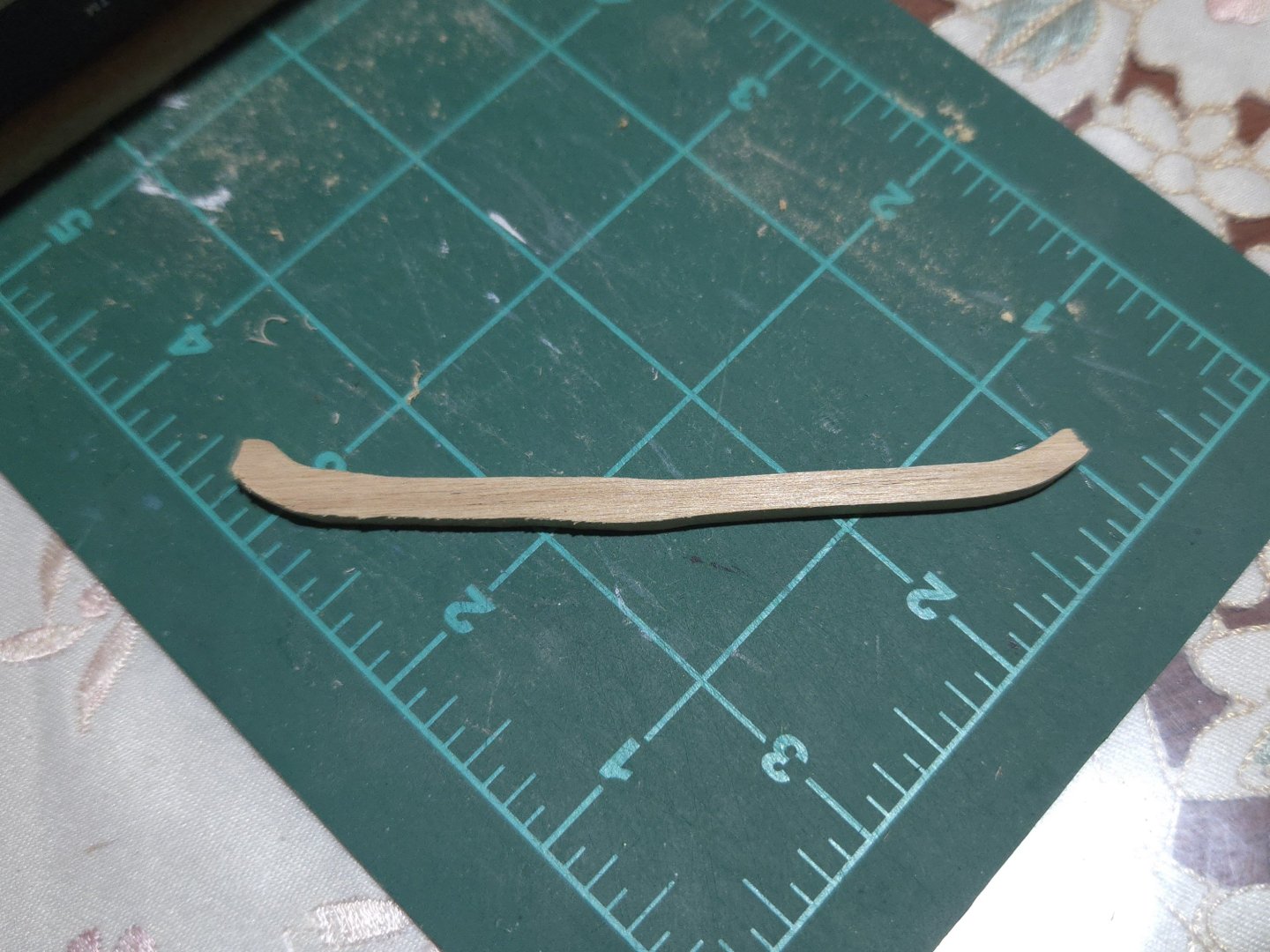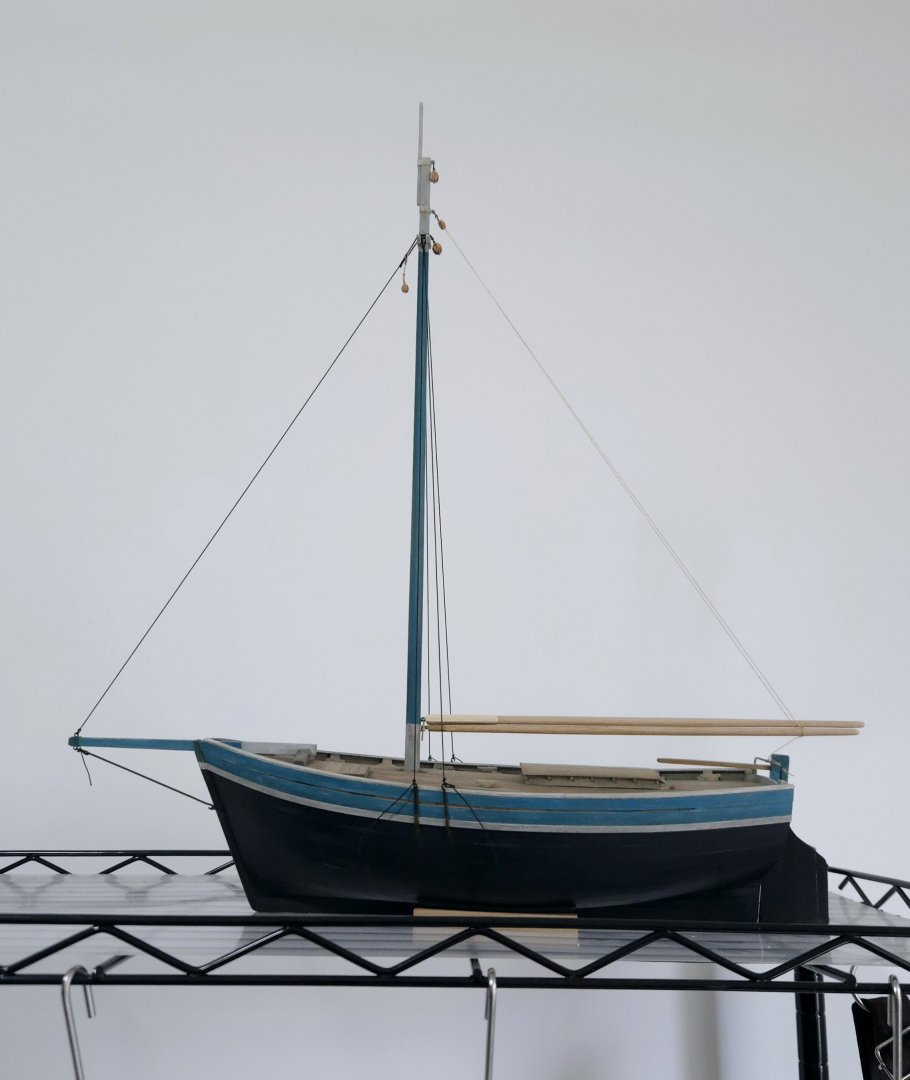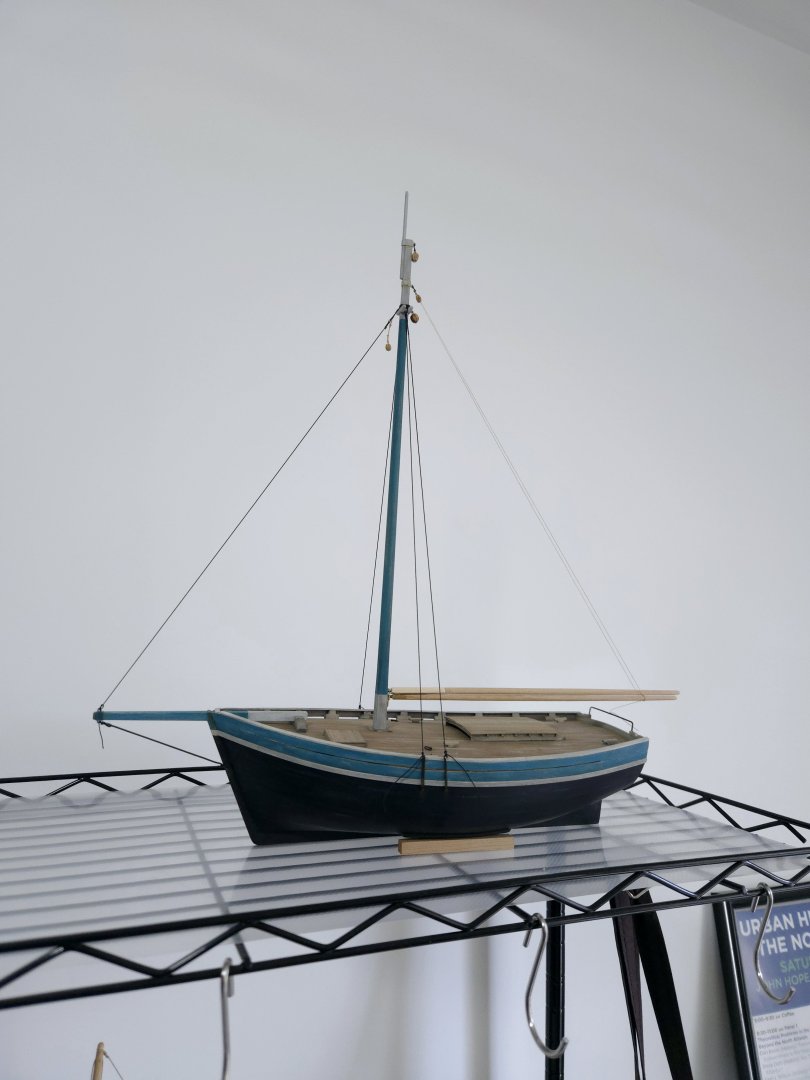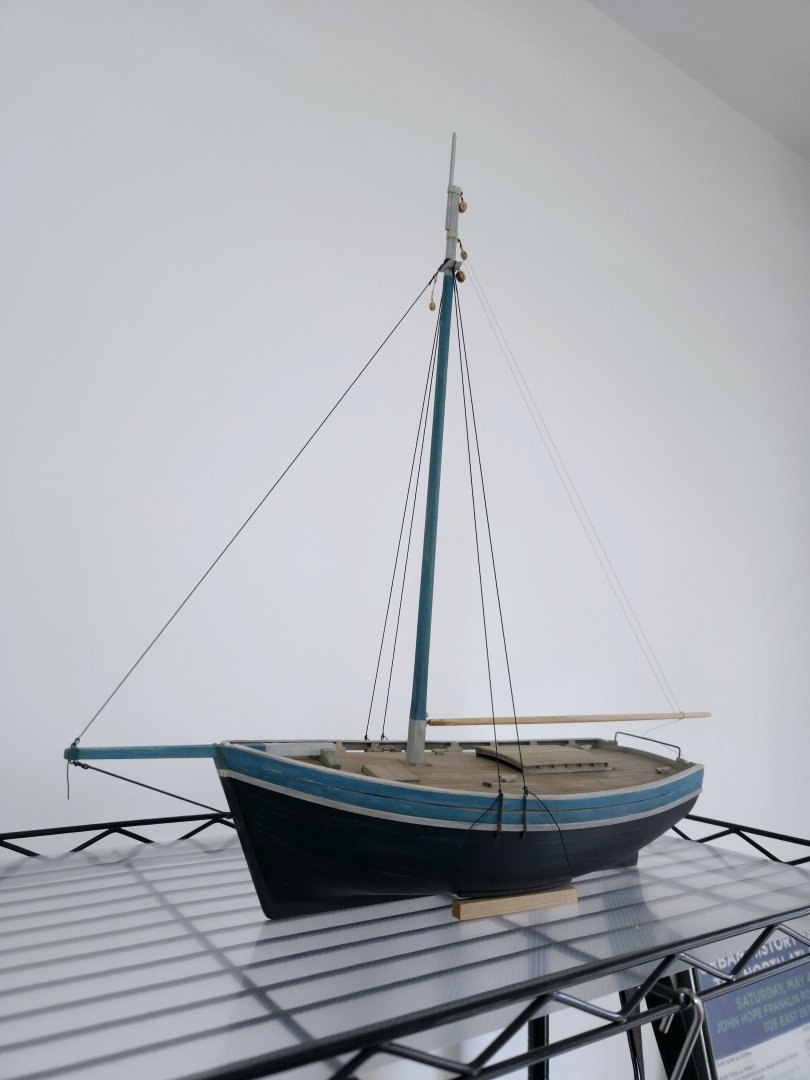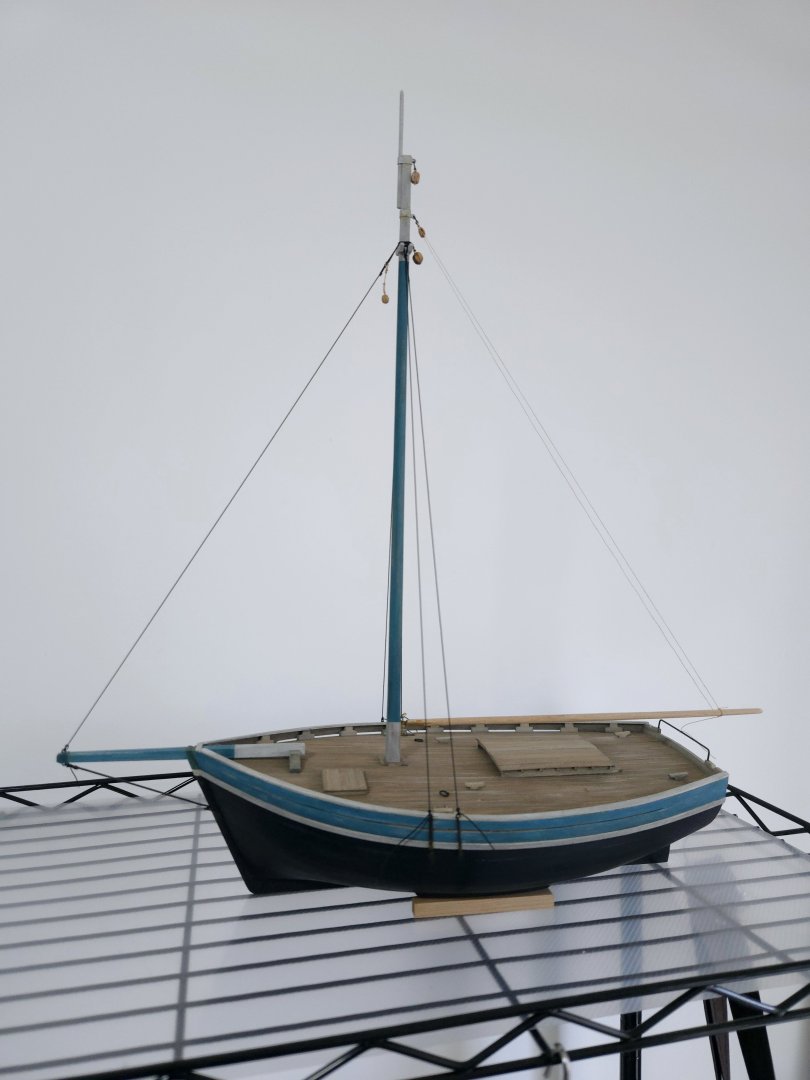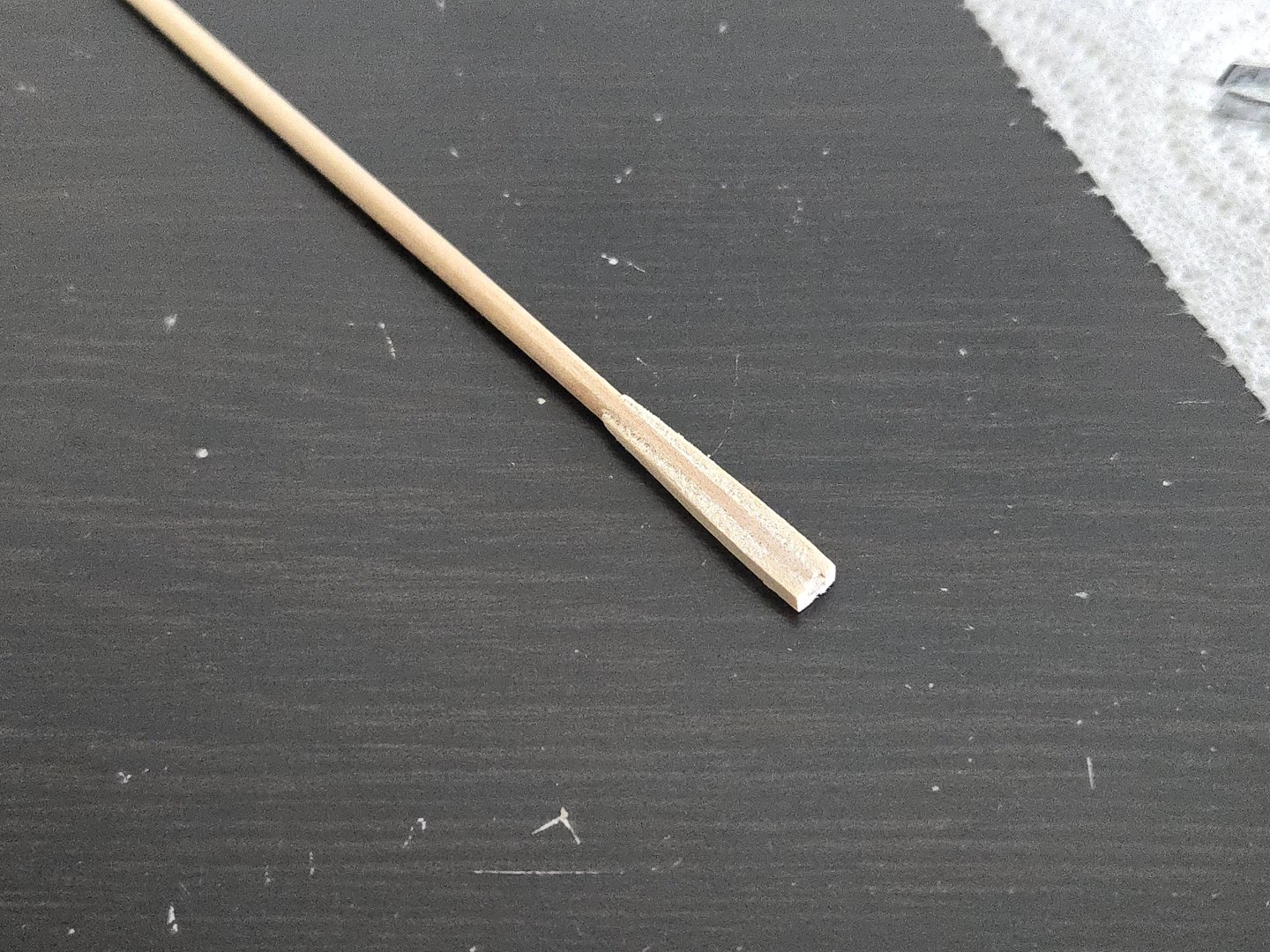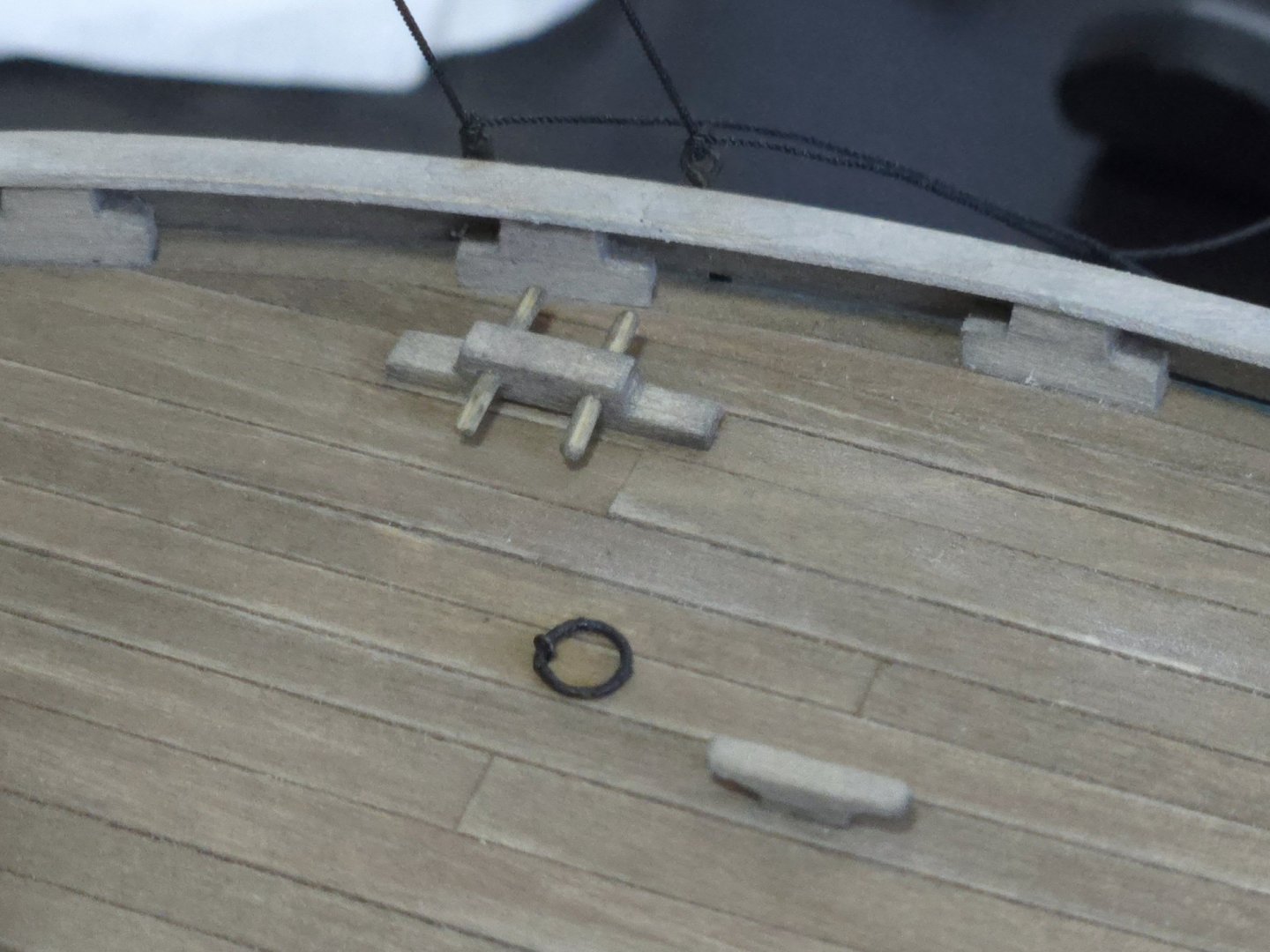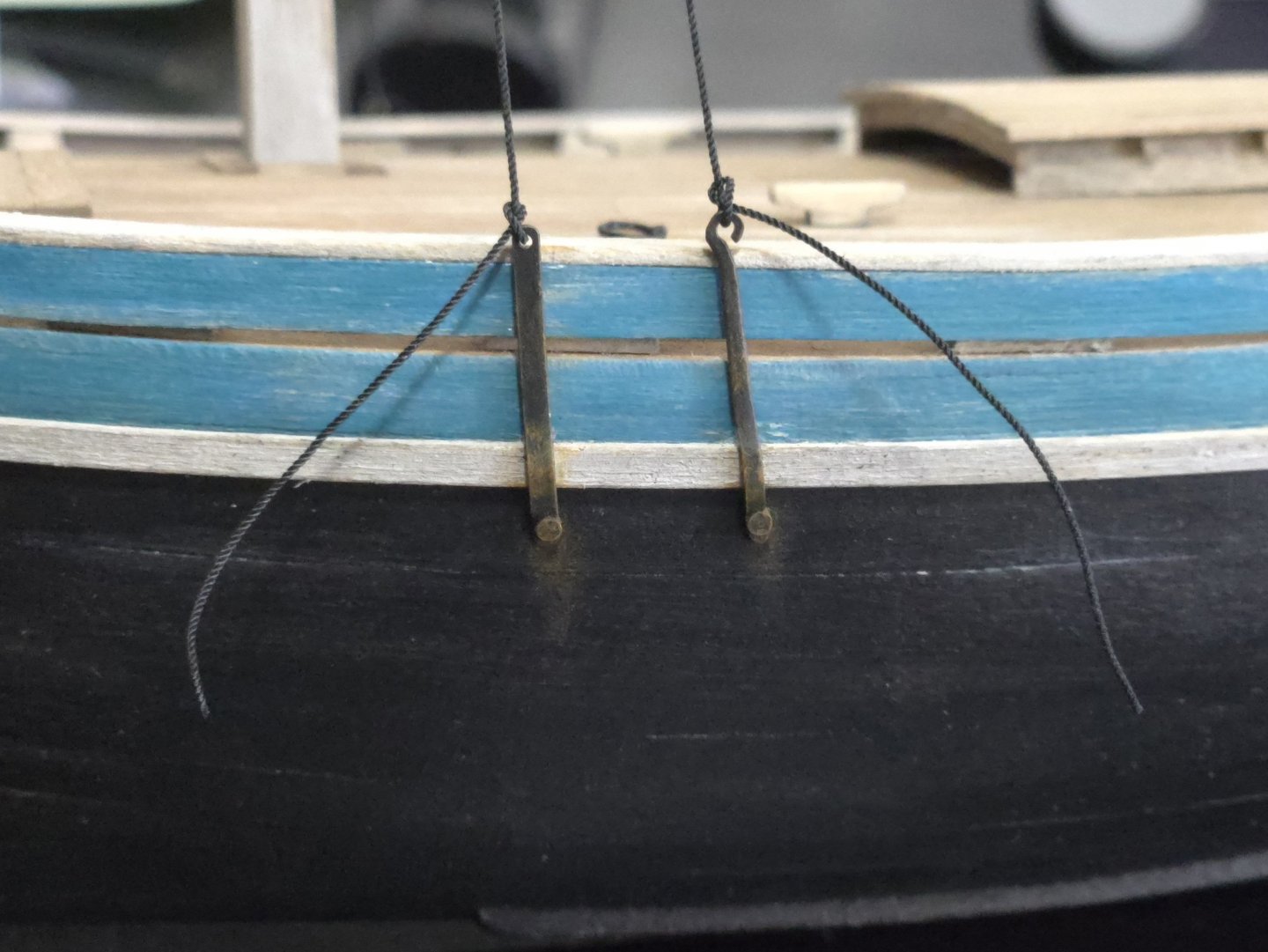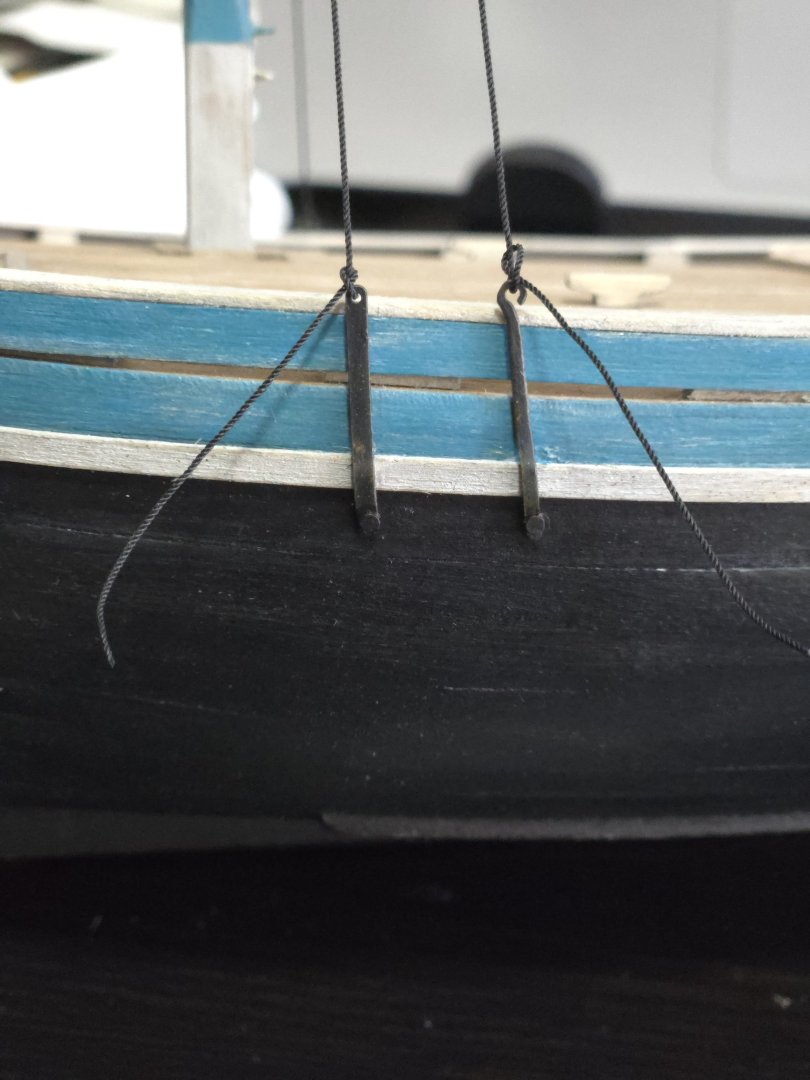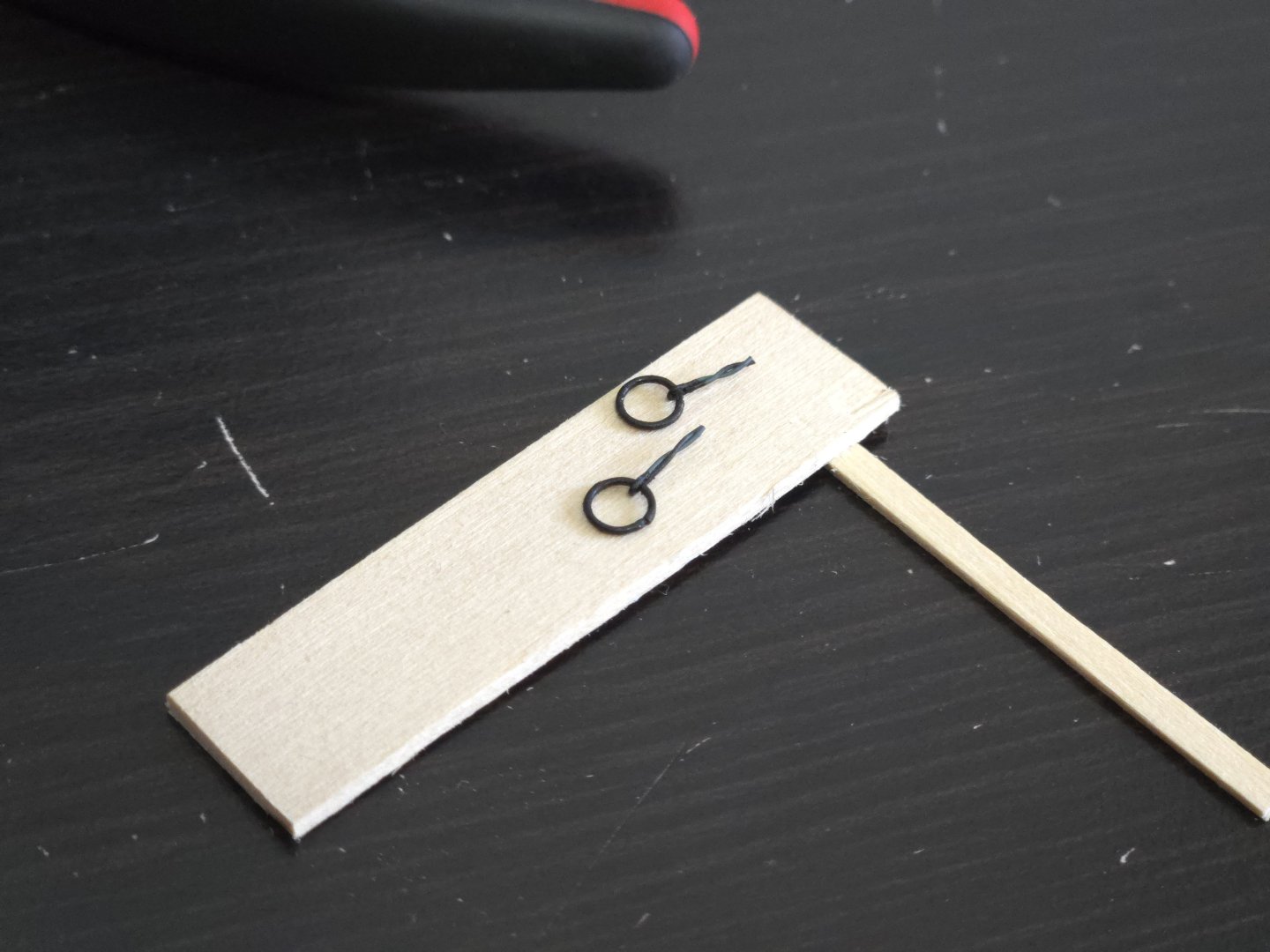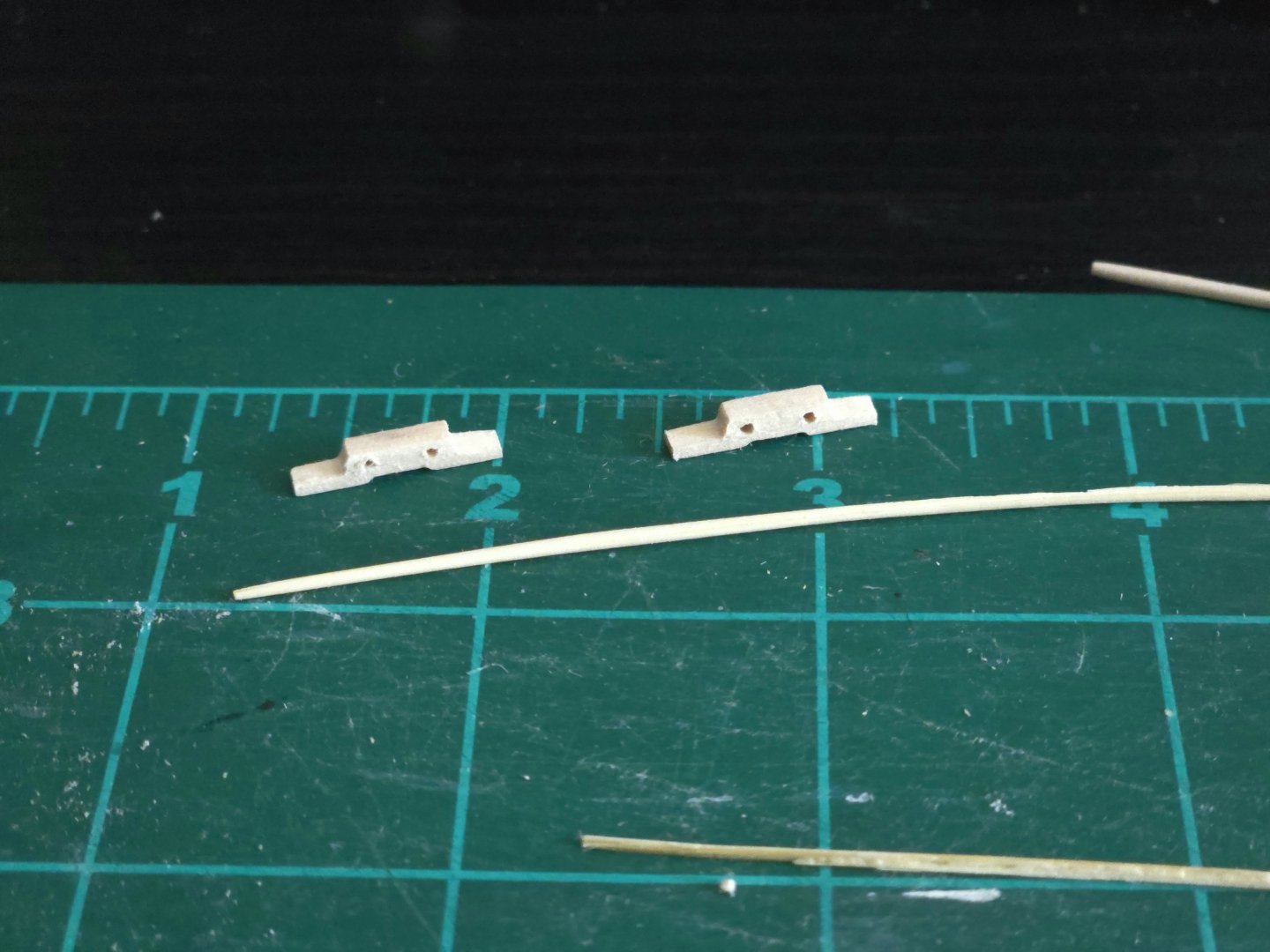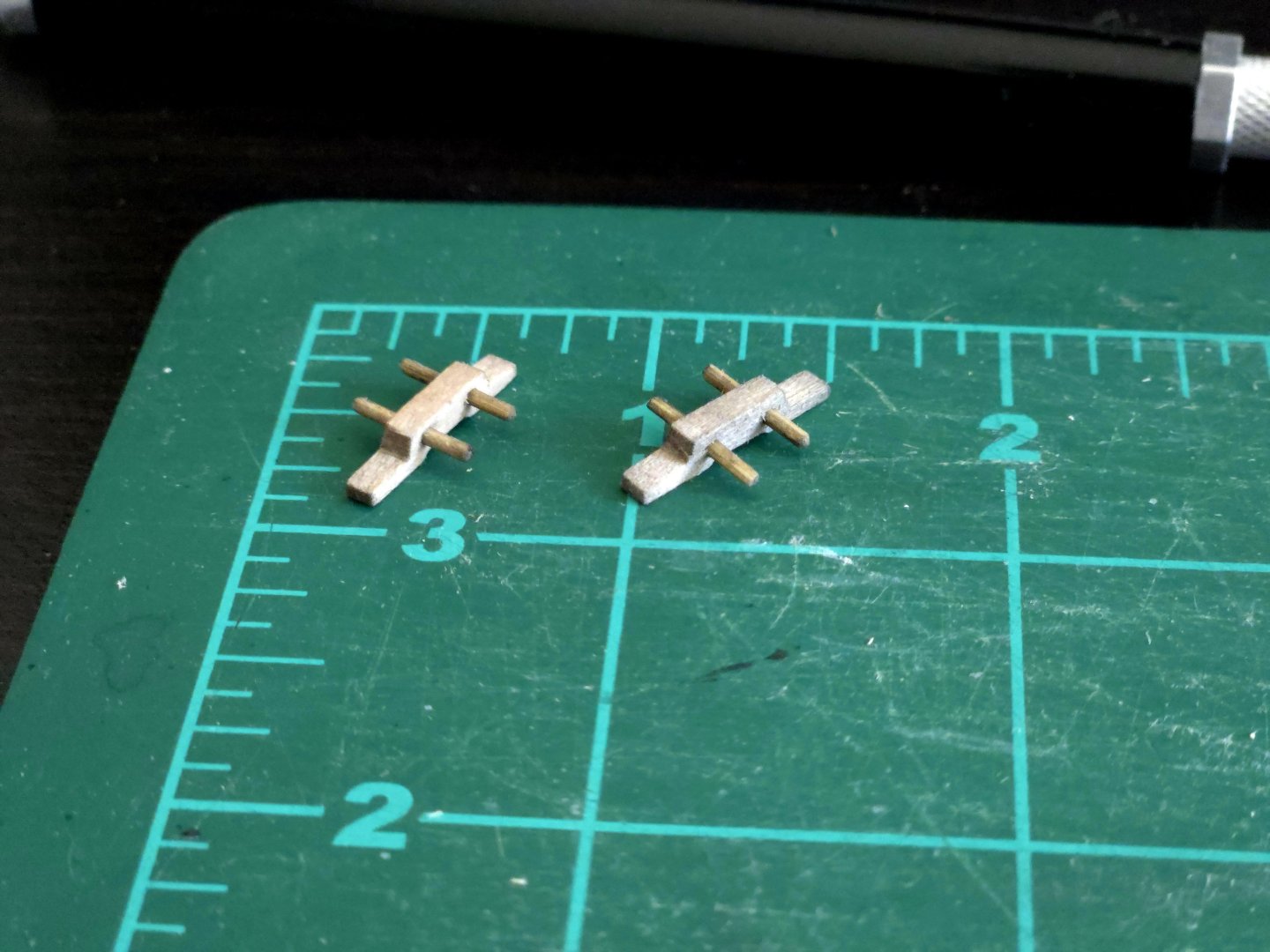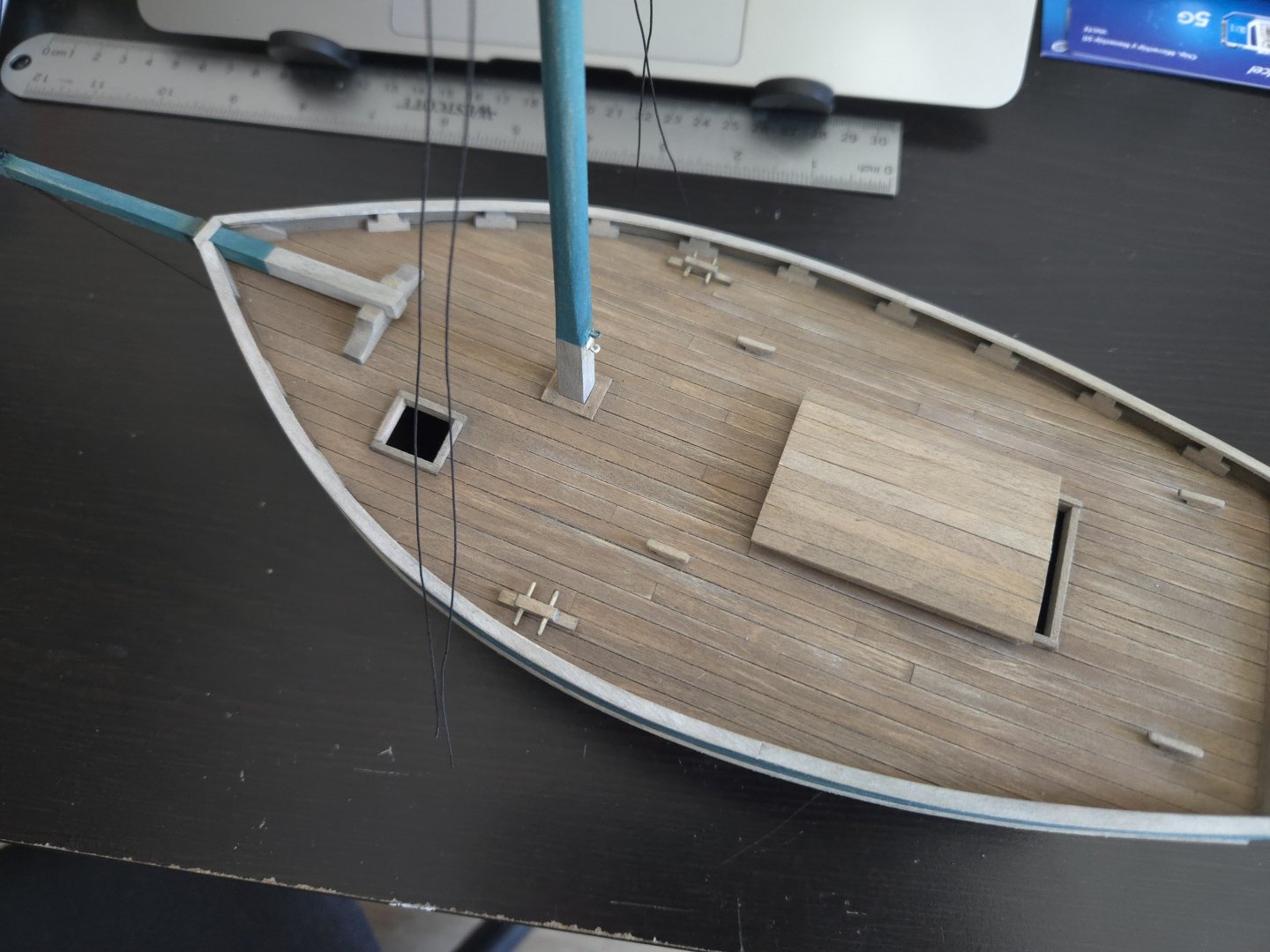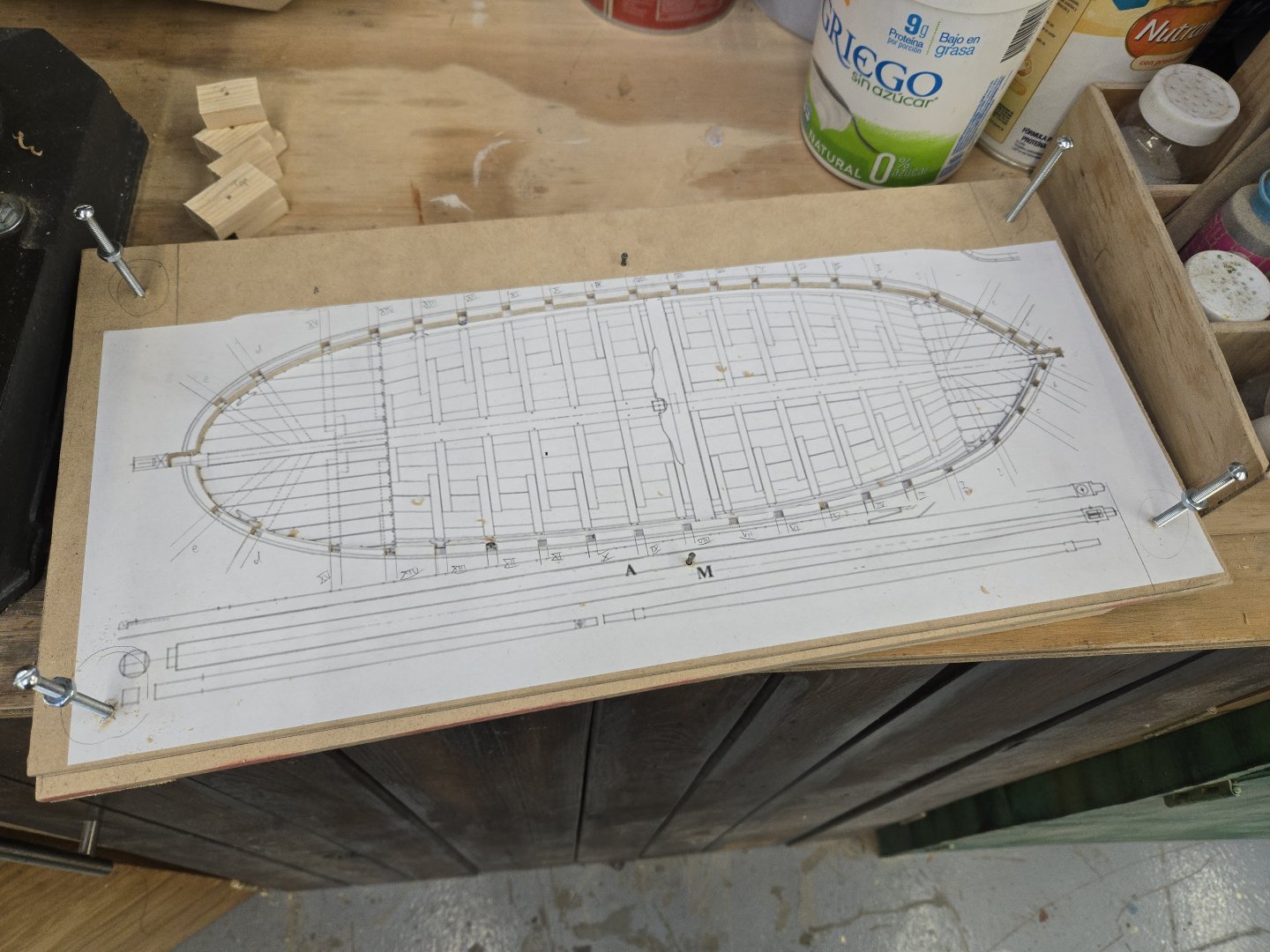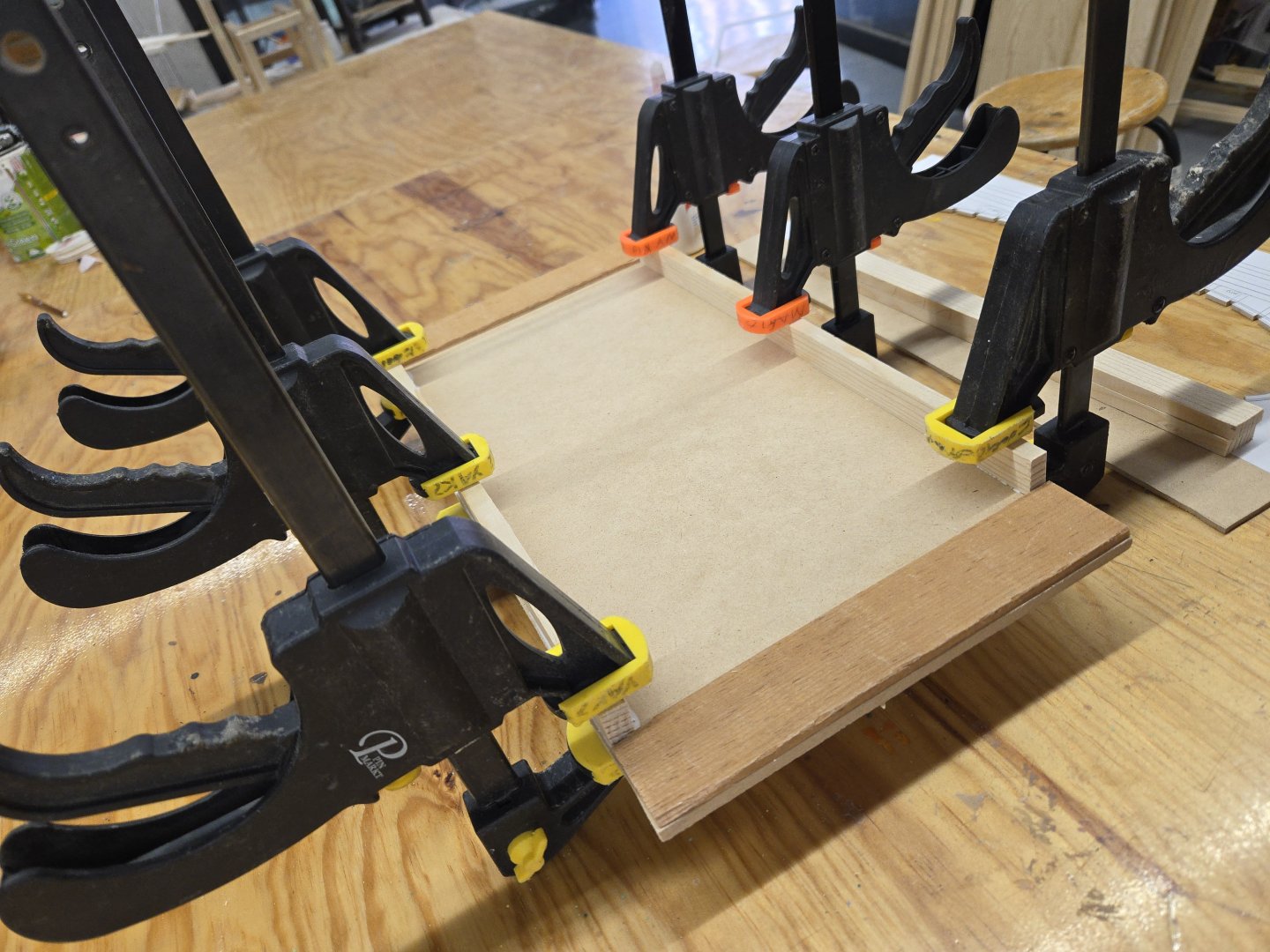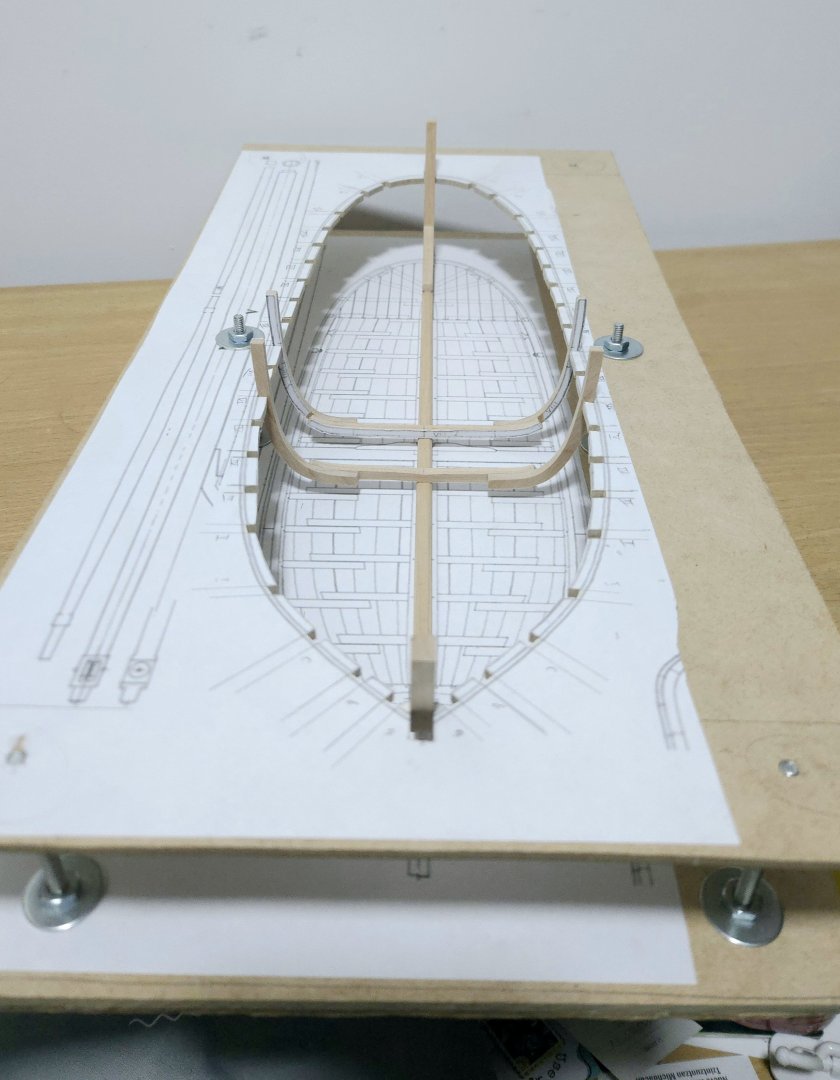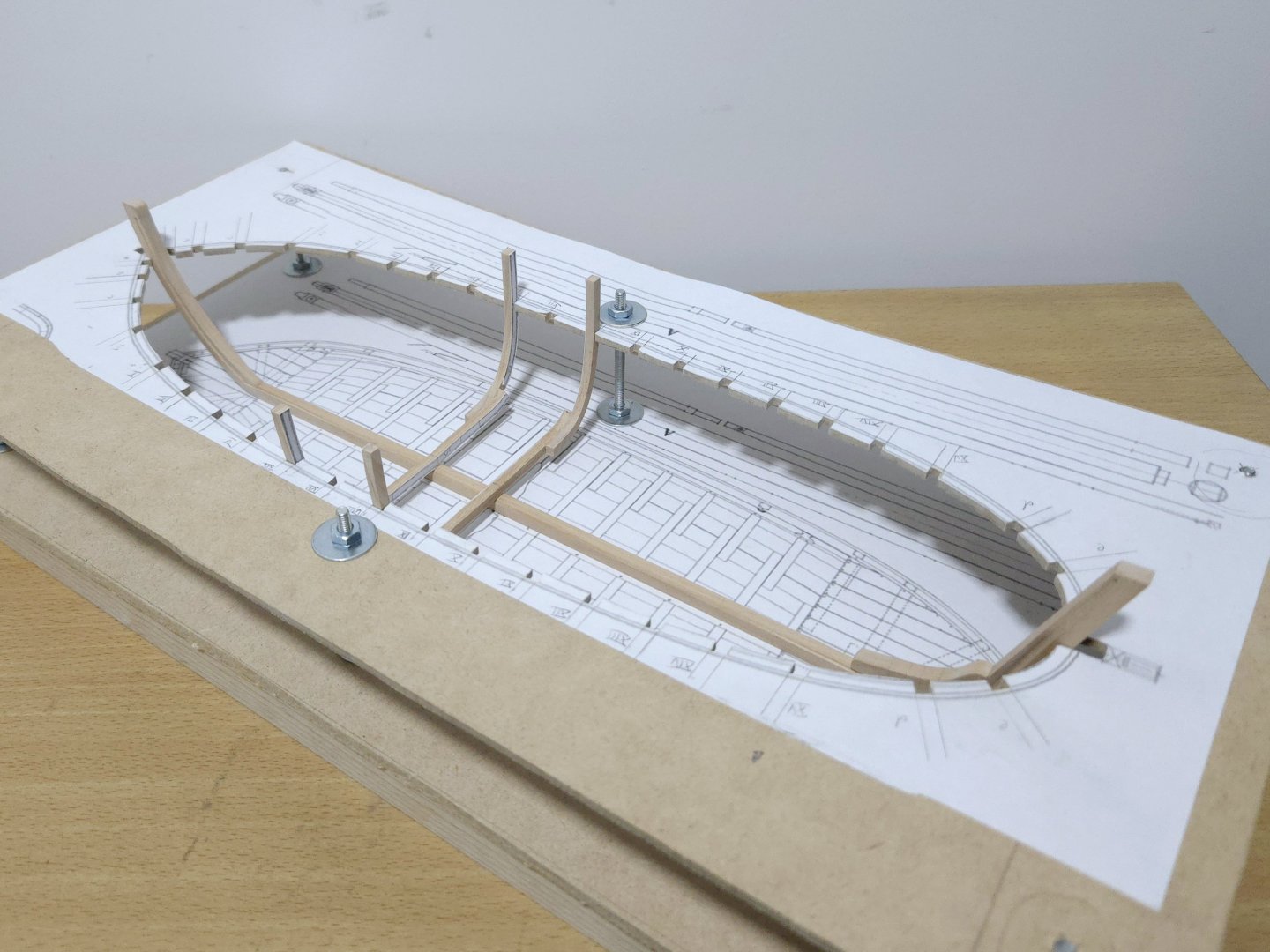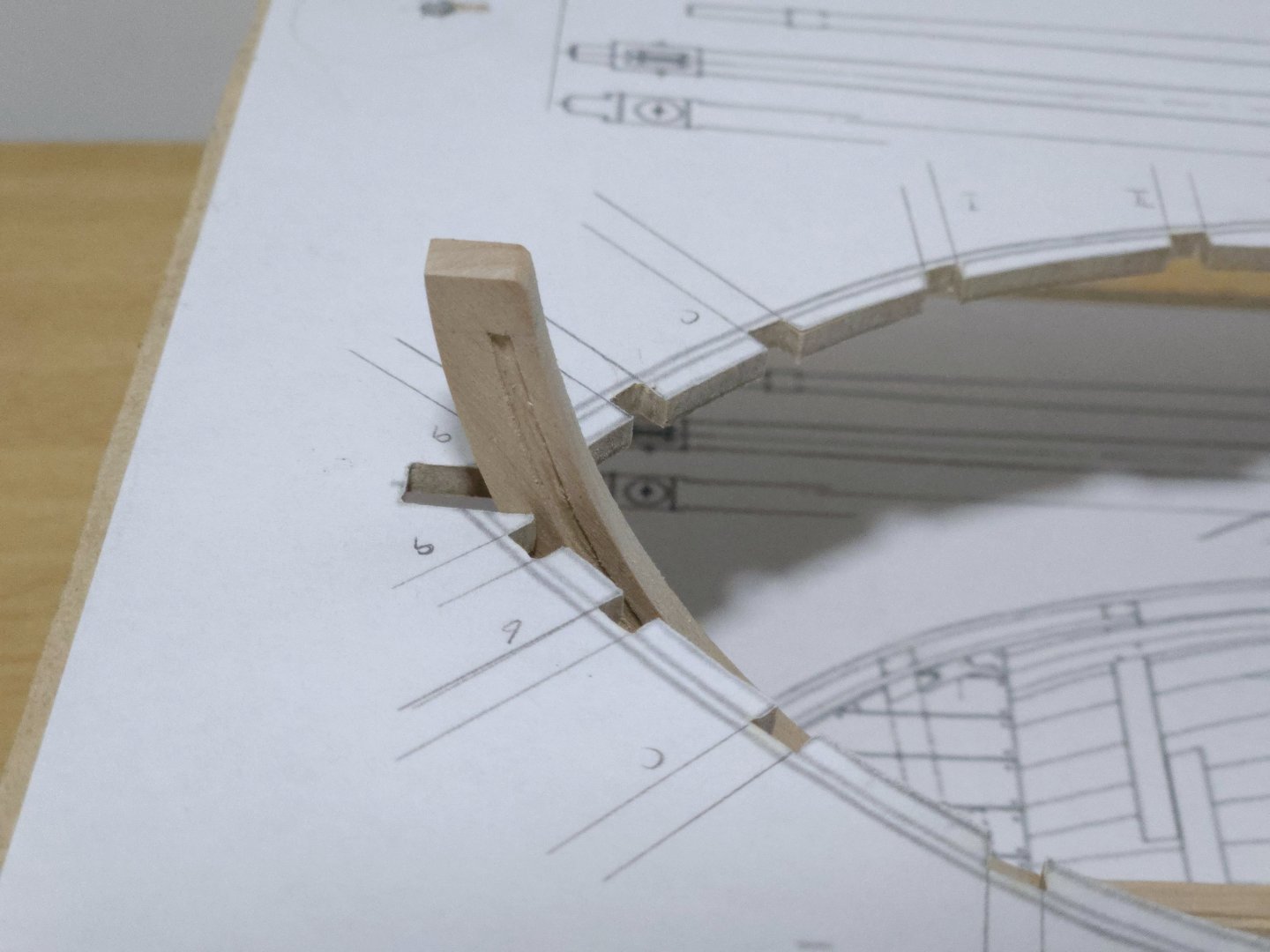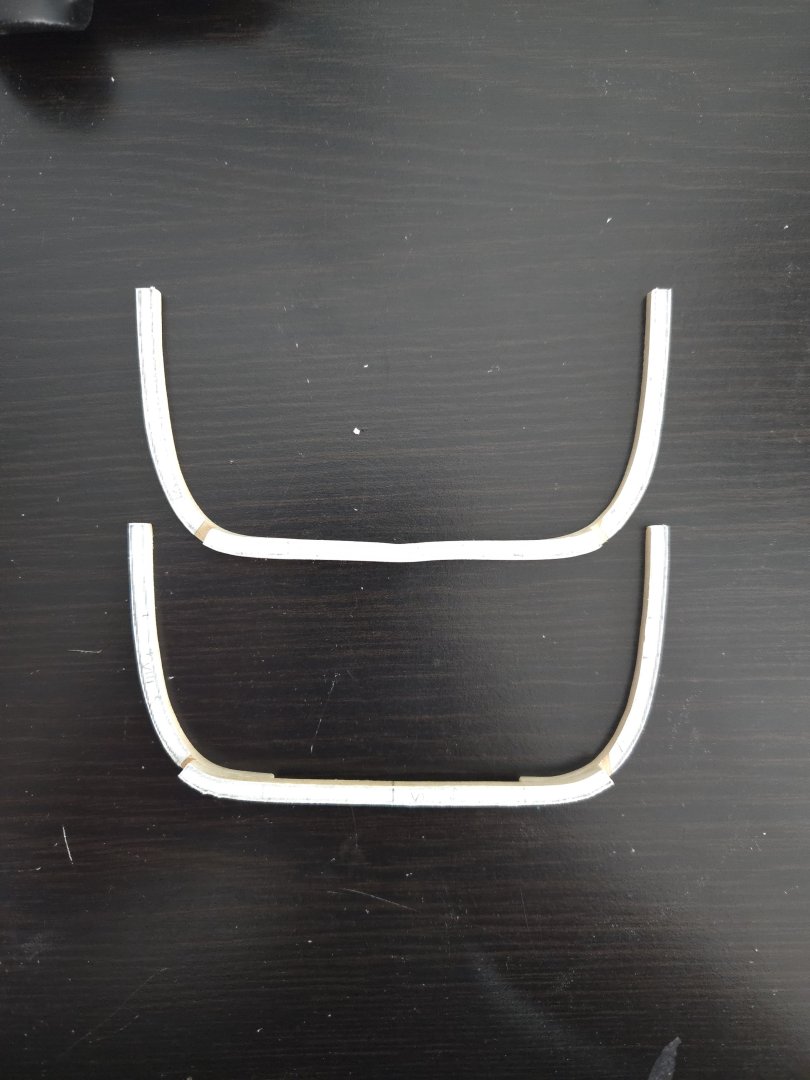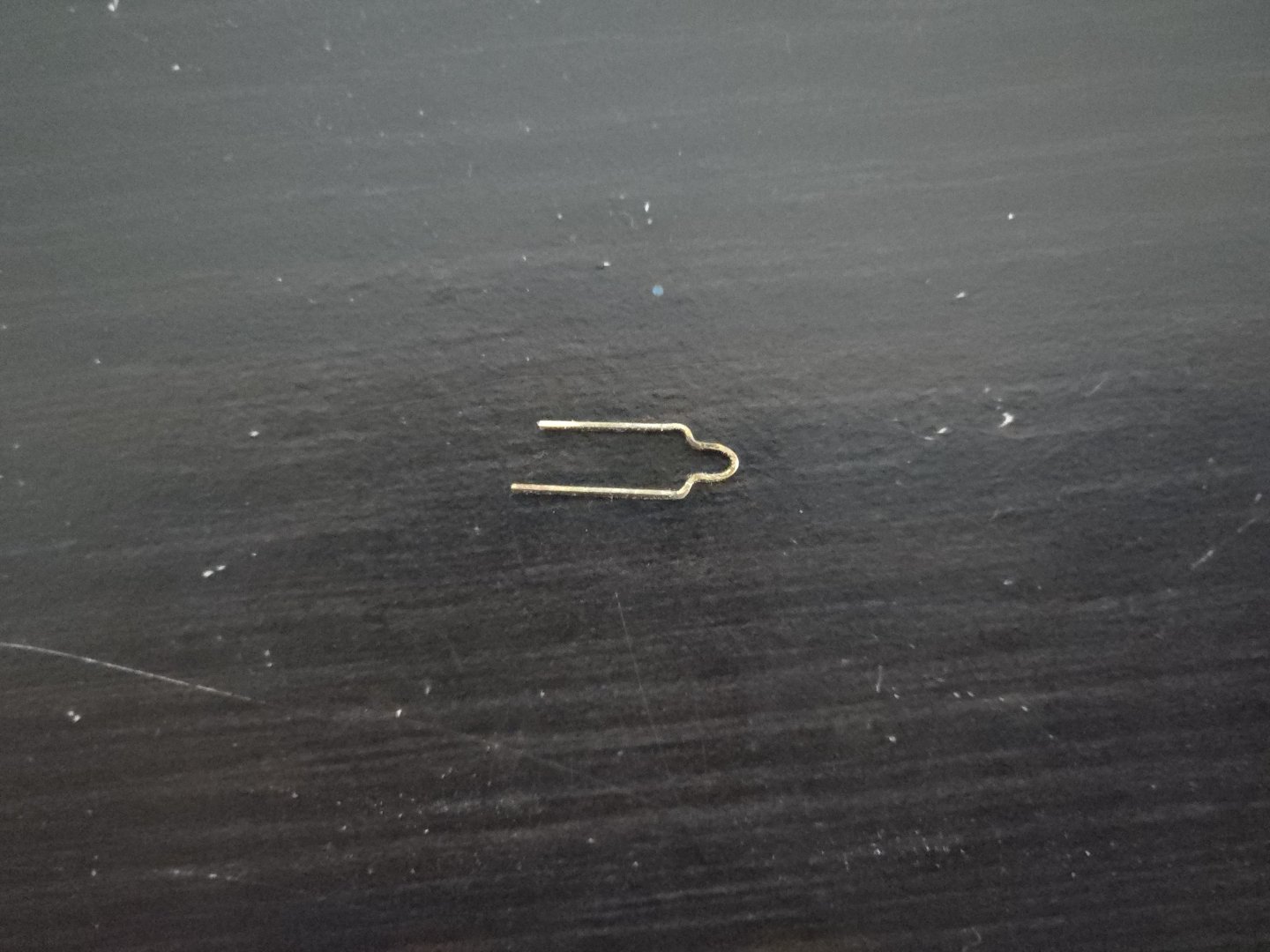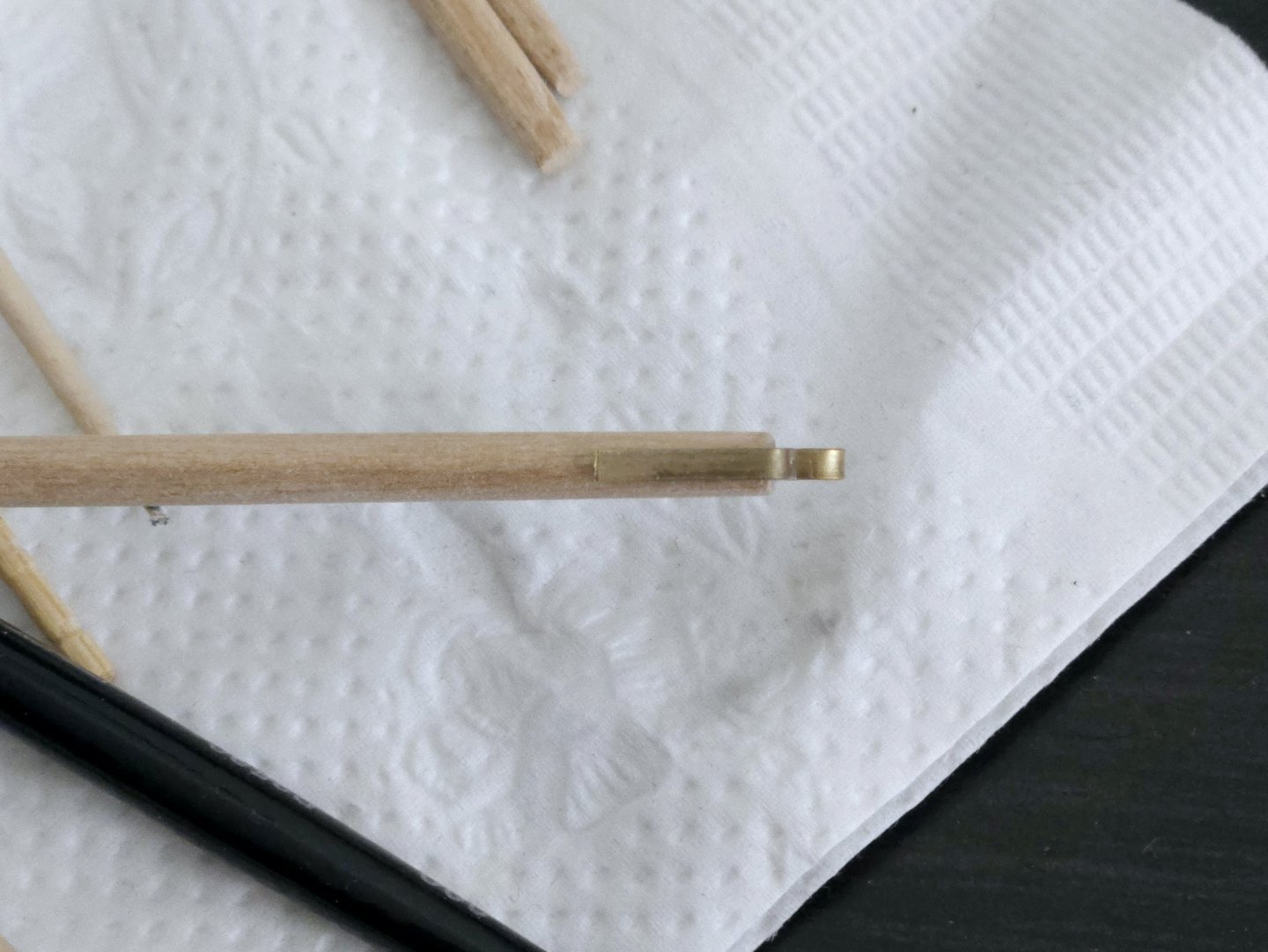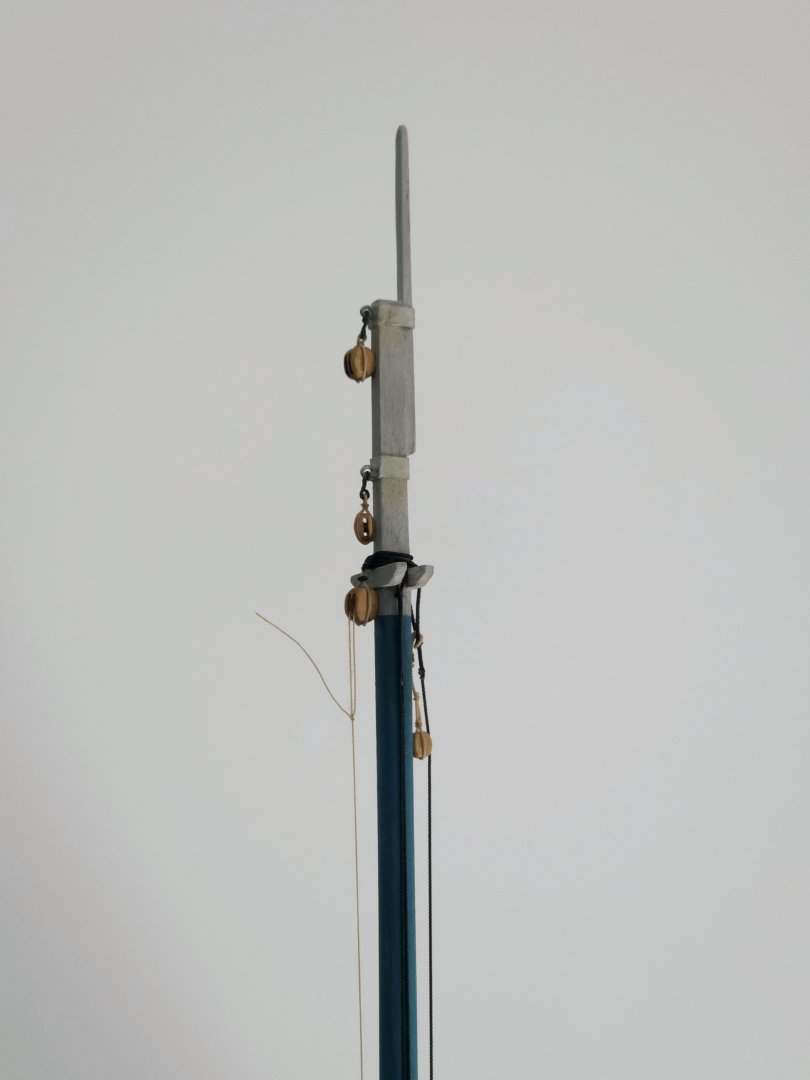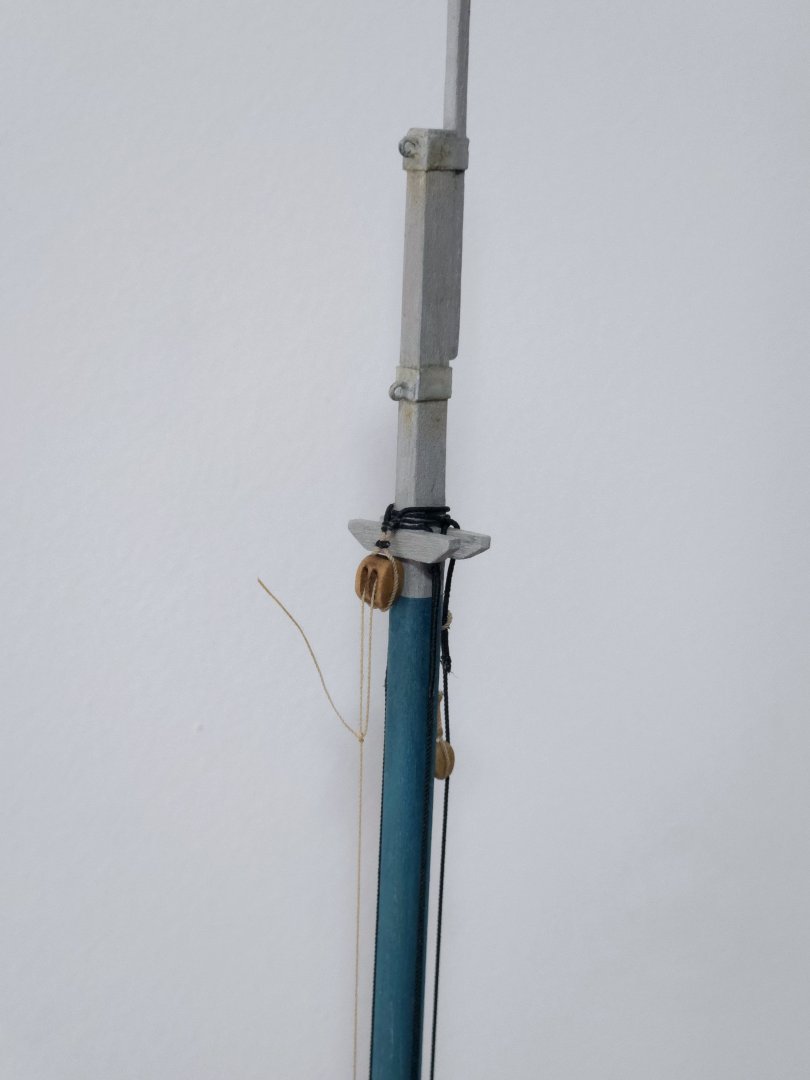-
Posts
1,308 -
Joined
-
Last visited
Content Type
Profiles
Forums
Gallery
Events
Everything posted by JacquesCousteau
-
Really fantastic job! To my eyes, at least, it still has plenty of quirkiness (in a good way). Hoping that all goes well for you!
- 732 replies
-
- Lula
- sternwheeler
-
(and 1 more)
Tagged with:
-
Thanks, all! I think that cardboard templates may be the way to go, as I suspect that I'll have to fiddle with things a bit to get the angles right. I may also try Paul's suggestion once I'm back from traveling, really anything that gives me a better sense of how this fits together will be helpful.
- 133 replies
-
- ancre
- Bateau de Lanveoc
-
(and 2 more)
Tagged with:
-
As I'm traveling at the moment, there's been no chance to get a rotor tool, or to do much work other than slowly sand a few frame parts I was able to bring with me. The floor from frame 10, below, is sanded to about the proper size on the right side (leaving a little extra for fairing), but still needs sanding on the left. For the remaining frame parts, I think I'll try cutting a little closer to the line, as I've gotten more precise with the fretsaw and leaving about 1/32-inch extra instead of 1/16-inch extra would significantly reduce the amount of sanding I need to do. In any case, I've realized that I'm not totally sure of how to cut the ends of the foremost cant frames (a and b). The drawings are mostly pretty clear about how the frames connect to the keel pieces, even when they do so at odd angles--in the plan detail below, for instance, it's clear how cant frame c at right is beveled and sits on the keel. However, you can also see that the interior ends of cant frames a and b, which should be attached to the stempost and thus ought to have a complex bevel, have practically no details, with the lines just stopping in mid-space. This is especially the case for b, which is oddly squared off--at least a is angled to meet the stem in one plane. So, I may be missing something obvious, but it's totally unclear to me how I'm supposed to cut the ends. If I cut between the ends of the lines, the result would be a squared block that doesn't fit against the stem. I could cut there and then bevel the result to fit, but I'm not sure if that would result in a piece that fits the hull properly. One might assume that the line ends represent the longest sides of the bevel (e.g , the outboard side of the frame reaching lower on the stem), but if they actually represent the shorter sides (e.g., the inboard side of the frame), then cutting at the line ends would result in too short of a piece. Thinking about it some more, I think that what I'll need to do is to use other drawings of the hull structure to measure the distance from one tip of the cant frame piece to the other, and then use that to figure out where the frame should be cut--whether at the line ends, or if I'll need to extend the frame lines a bit following the same curve. I don't bring this up to be overly critical, as the planset still seems generally quite excellent, but to instead signal potential issues to other modelers. This is another issue where I can't help but feel that the plans could be a little clearer.
- 133 replies
-
- ancre
- Bateau de Lanveoc
-
(and 2 more)
Tagged with:
-
Very nice work on the pilot house. Sorry to hear about the medical issues, hope all goes well!
- 732 replies
-
- Lula
- sternwheeler
-
(and 1 more)
Tagged with:
-
It can be helpful to rub a pencil along the edges of the bulkheads while fairing, because you can easily see how much you've taken off that way and make sure that you're not overdoing it and destroying the shape of the bulkhead. I second Bob's suggestion to try bending a plank and seeing how it fits, as a moistened and heated plank will bend more than a batten. You wouldn't necessarily need to bend it exactly (as the exact bend required changes with each plank), but getting a good approximation will still be helpful. That said, if it's stillbreaking or nearly so upon bending over the bulkheads, that is a sign that you need to sand more. I had that same issue at the bow of my NRG Half-Hull model, and it took a lot of fairing to get it right. Good luck!
- 25 replies
-
CA certainly has its uses! I use a sharpened toothpick to apply mine. Another option without quad hands that might help with getting the mast vertical might be to make a very simple jig from scrap wood. If you have a bit of wood wider than the mast diameter, and longer than the beam at the mast location, you could drill a hole for the mast in the middle, rest it on the gunwales across the hull over the mast step, and drop the mast through the hole into the step. Then you can move the jig around until the mast is centered left-right and at the right rake, and glue some chunks of scrap on the bottom of the jig snug with the gunwales so that the jig (and with it, the mast) can't move side to side or back. This would eliminate a lot of potential movement in the mast, and while it could still slide forward, that could probably stopped with something (rubber band, rubber cement or a tiny dab of gluestick, prop made of scrap, etc). A more complex version might use a slightly oversized hole and some tiny scrap wedges to finesse things if the jig turns out slightly off.
- 167 replies
-
- Norwegian Sailing Pram
- Model Shipways
-
(and 1 more)
Tagged with:
-
Wow, seeing it on the shelf like that next to the books really brings home what a small model it is. It's tiny! Which makes the workmanship all the more impressive.
- 142 replies
-
- alfred
- solid hull
-
(and 2 more)
Tagged with:
-
CA glue is definitely useful for rigging, although I have seen others use shellac or other varnishes instead. The brush-on kind or the gel are easier to control than the tubes of liquid. You can dab it on the end of rigging line to keep it unraveling (especially useful for scale rope that can unravel when cut), and can cut the glued portion at an angle to get a sharp-tipped "needle" in the line for threading. Sometimes you also have to drill out the holes in metal fittings to get the line through, too.
- 167 replies
-
- Norwegian Sailing Pram
- Model Shipways
-
(and 1 more)
Tagged with:
-
Thanks, all! @wefalck, I can definitely understand the appeal of a nice clean model, and am considering building the Bateau de Lanvéoc that way. But I felt that this model was particularly well-suited for a more weathered look. I think it also conveys something about the broader context in which these vessels sailed, maybe telling a story (or at least hinting at one) about their sailors' lives. (Of course, one could also say the same about the Bateau, which is also a workboat, but there I have the excuse of wanting to show off the framing.) Not much work for the next week or so, as I'll be traveling, but I was able to make a new, better-tapered gaff. Still need to figure out the jaws.
- 312 replies
-
- Chile
- Latin America
-
(and 6 more)
Tagged with:
-
Definitely a tricky mast to rig with the upright angle controlled solely by the rigging! While it's certainly frustrating, and it's of course up to you what you do, I'd suggest redoing the shrouds and stays to get a result you're satisfied with. The rest of the model has turned out quite nice, including additions like the served rigging not usually seen on this model, and it seems to me like it would not take that much time, relatively speaking, to bring the standing rigging up to the same standard. It sounds like part of the issue was in setting the shrouds before the fore stay. Maybe setting the forestay first would help? Another option may be to fudge things a bit (or let's call it personalizing the boat) by making a new, wider thwart from scratch and drilling a hole in the midline to create a more stable foundation for the mast. I did something similar on my Dory build, which I added a sail to, but I'm not sure if it would work on this particular model. Anyway, it's your model, just thought I'd add my two cents.
- 167 replies
-
- Norwegian Sailing Pram
- Model Shipways
-
(and 1 more)
Tagged with:
-
Very nice work! Personally I think having the upper deck mostly unplanked would look great and would really show off the framing.
- 76 replies
-
- Pinas
- kolderstok
-
(and 2 more)
Tagged with:
-
Thanks, all, for the comments and likes! A bit of a minor setback, but also some progress to report. I began work on the gaff, also making it from alder like the boom. Unfortunately I slightly over-tapered the portion nearest the mast. I then had trouble with the jaws. Given that they need to curve in two directions (outward to fit around the mast, and upward so they wrap around it when the gaff is raised and angled up), I thought I might try to build them up from layers. However, I made the lowest layer over-long (photos show they were usually pretty short) and compounded the error trying to use sawdust, glue, and sanding to blend it into the gaff to make up for over-tapering it. It's not a total waste as I'll be able to trim the end and re-use the spar on some subsequent model, but for now I'll need to remake the gaff. In happier news, I finished up the belaying points. Many lanchas had a sort of double cleat formed by running rods through a wooden block. To make mine, I more or less followed the dimensions given in one of Graham's sketches, cutting them from 3/32-inch thick scrap and shaping with a file. To make the rods or pins, I wasn't sure how well basswood or a thinned toothpick woud hold up, so I cut up a bamboo coffee stir stick. I then gave everything a coat of black wash. And here, the belaying points in place. My belaying point plan differs slightly from that shown in the plan set, instead being based on photographs and Graham's sketches. I also needed to add a pair of metal rings in eyebolts, making them of wire and painting them black. While some of Graham's sketches show eyebolts located at different locations on the port and starboard side, I decided to make mine symmetrical, following what I could make out from Vairo's photos. I also got the chainplates attached to the hull. To get the angle right, I first determined their location, then ran the shrouds through the end and back up again, and applied slight pressure while holding the bottom of the chainplate in place. I then marked the nail hole, drilled it out, placed the nail through the chainplate and partly into the hull, and again used the shrouds to get the angle right before applying super glue to the nail and back of the chainplate, and snugging both up against the hull. As can be seen, I've loosely tied off the shrouds for now, mostly to keep them out of the way--I still need to add hooks and turnbuckles to finish off the shrouds. I then dry-brushed a bit of rust. Looking at it in close-up, I may tone it down slightly on the nail head. There was also a little excess super glue, which was cleaned by scraping, adding to the weathering effect. I similarly tied off the fore stay, and took a look at how the build is coming now that it has more rigging (also temporarily adding the boom, which still needs paint). I'm liking how it's coming together so far. And with the failed gaff temporarily added, giving a sense of how it would look if I don't add sails.
- 312 replies
-
- Chile
- Latin America
-
(and 6 more)
Tagged with:
-
Amazing work, the model looks incredible! I like the choice to leave it undecked and half unplanked, too.
-
Thank you, all, for the detailed suggestions! That's too bad to hear that the dremel drill press is so flimsy, and that the dremel tools themselves are poorly regarded. Given the price of a quality Proxxon tool, I may leave it for the future but keep my eyes out for any deals. In the meantime, I might get a cheap, small rotary tool. Hopefully it will work well enough for my very limited purposes, and if not I guess it might confirm that I need a better quality tool. Anyway, a bit more progress on the Bateau. Using the hand fretsaw, I've continued cutting out frame pieces. The carpentry workshop has an electric scrollsaw, which seems worth learning how to use. So far, though, my practice runs on scrap mdf have mainly shown me that I need a lot more practice on the machine before I'm using it on my limited stock of alder. For now, I'm much more comfortable using the hand saw. I also got the building jig put together (well, more or less, as will be seen). The base is made of relatively thick mdf, and I decided to strengthen it on the underside with some scrap wood strips. The fore-and-aft strips (seen being glued, below) are much thicker than the side-to-side strips at the front and back of the jig, in order to provide space under the jig for the bolts. I then lined up the top and bottom templates and, using a drill press, drilled holes for the bolts. I was then finally able to get the jig set up, and dry-fit the keel assembly and the couple frames I've completed. It was exciting to suddenly see the build in 3D! That said, there were a few issues to correct. I still need to add some sort of brace pieces to hold the keel centered, and clearly need to get longer bolts--in the test fit photos, the top jig is just resting at the very top of the fore and aft bolt pairs, and is still slightly too low to bring the jig in line with the wales. Which brings me to the biggest problem. Earlier, I mentioned that the frame drawings were wider than the top-down hull view, and ultimately decided that the top-down view must have been aligned with the wales. Now, however, I see that that can't quite be right, as if that were the case, the stem and sternpost would be a bit closer together. In the photos above, you can see that there's quite a bit of space in the jig in front of the stem and behind the sternpost. The top-down plan drawing, then, shows the full length of the hull, rather than just the length at the waterline or wales. So, if I try to use the jig at the wale level--at which point the jig is the proper width for the frames amidsgips--it will be totally off at the bow and stern. As can be seen, if I tried to use the jig at the wale level to fit the foremost cant frame, for example, the cant frame would practically end up intersecting the stem outside the rabbet. It's not an insurmountable difficulty. I think I'll just file the frame slots out wider (equally so on each side), get longer bolts, and mount the jig at the level of the top of the hull. It's just a bit if a mystery to me why the top-down drawing is narrower than it should be.
- 133 replies
-
- ancre
- Bateau de Lanveoc
-
(and 2 more)
Tagged with:
-
Very nice work! The serving looks great. For serving at smaller scales (such as on the lobster smack), fly-tying thread works well.
- 167 replies
-
- Norwegian Sailing Pram
- Model Shipways
-
(and 1 more)
Tagged with:
-
Progress has nearly ground to a halt, as I've been very busy with work and my hobby time has been focused on rigging the Lancha Chilota build (something that has proven much less tedious so far than I thought it would be) and, in my carpentry class, building a TV stand/bookshelf. I've put together one further frame, number VI, seen below with frame VIII. I've also filed out the frame slots in the building jig. Each frame takes a lot of time, most of which is spent in slowly sanding the frames into shape, leaving a little extra for fairing. I don't have any power tools, so I'm just using sanding sticks. This is extremely tedious, and I'm beginning to wonder if I should get some sort of power tool. Here in Mexico, I can pretty easily get Dremel rotary tools and various knock-off versions. Other manufacturers, like Proxxon, are substantially more expensive. Most disc sanders that I see available are much too large and attached to a belt sander, which I don't need, and in any case it doesn't seem like they would be useful for sanding the concave shapes on the interior of the frames. So I wanted to ask if anyone has any recommendations on what to look for in a rotary tool. What rpm range would be appropriate? And how useful is the dremel workstation (the thing that looks like a small drill press)? I'm thinking that it could be useful to essentially turn the dremel into a spindle sander, but I don't know if it's too fragile for that. (I should note that I don't have any ability to machine metal to make my own.) Thanks in advance for any advice!
- 133 replies
-
- ancre
- Bateau de Lanveoc
-
(and 2 more)
Tagged with:
-
Nice job! That said, you may want to double-check that the bulkheads are on square to the keel. Maybe it's the angle, but in the first photo they look a little crooked, which might cause problems with the hull later on.
- 12 replies
-
- English Pinnace
- Model Shipways
-
(and 2 more)
Tagged with:
-
You may want to check out Chuck Passaro's guide to stropping blocks, which is available as a pdf for free download at Syren's website on the "blocks" page. I found it extremely helpful for figuring out stropping techniques, and relatively easy to do. I'm not totally sure about the best way to add a loop to both ends, though. In general, searching MSW for "block stropping" should return helpful results. Best of luck!
-
I started work on the rudder hinges, making one out of 1/64x1/16‐inch brass strip. It ended up protruding about 1/8 inch beyond the rudder, which is a bit more than I would like--as can be seen below, the gap is a bit excessive. I still have a hard time making precise bends in brass, which is part of why it sticks out too far. As can be seen below, the 90-degree bends aren't very precise, and the bend for the pintle is simply too big. I'll have to try again. That said, it occurred to me that this piece could also potentially be used to replace the eyebolt on the end of the boom, as seen below in a test fit. This would fill a little more of the excess space between the gooseneck eyebolts. The main issue is that the loop for the gooseneck pin is quite large, so the boom will bounce around quite a bit more than with the eyebolt unless I pinch the loop closed or something. With the metalwork (real and faked) on the mast finished, I was able to add all the standing rigging to the masthead. The shrouds were put in place and seized together with black fly-tying thread, first the starboard pair, then the port. Then, the fore stay was added. I made sure the standing rigging was snugged down against the crosstrees, clamped the lines at the bottom of the mast with clothespins to add a slightly bit of tension, and then applied watered-down white glue to hold everything in place. It was then time to add the throat halyard block, which, instead of being hooked to an eyebolt like the other masthead blocks, is stropped around the masthead. This proved tricky to do. First, I served a short length in the middle of a bit of rope. I then looped the served portion around the masthead and tried to seize the loop closed. This was very difficult for me to do, as there were a lot of moving parts to juggle--the rope, the seizing thread, and the mast itself were all sliding around. Eventually I used a dot of glue to secure the rope to the masthead in the proper location, but it was still tricky to seize it shut. I ended up deciding to seize it a bit further down the line first, as shown below, and then to seize closer to the masthead. While this certainly made it easier to add the closer seizing, unfortunately, that first seizing wasn't quite centered. I therefore added a further, properly centered seizing between the two I had made, to be against the top of the block, and then cut off the lower seizing, carefully removing the glued fibers as best as I could. I was then able to finally add the block, as can be seen below, which I held down in the proper position with sewing thread before adding watered-down glue to hold everything in place around the masthead. With all the blocks added, the masthead is now complete!
- 312 replies
-
- Chile
- Latin America
-
(and 6 more)
Tagged with:
About us
Modelshipworld - Advancing Ship Modeling through Research
SSL Secured
Your security is important for us so this Website is SSL-Secured
NRG Mailing Address
Nautical Research Guild
237 South Lincoln Street
Westmont IL, 60559-1917
Model Ship World ® and the MSW logo are Registered Trademarks, and belong to the Nautical Research Guild (United States Patent and Trademark Office: No. 6,929,264 & No. 6,929,274, registered Dec. 20, 2022)
Helpful Links
About the NRG
If you enjoy building ship models that are historically accurate as well as beautiful, then The Nautical Research Guild (NRG) is just right for you.
The Guild is a non-profit educational organization whose mission is to “Advance Ship Modeling Through Research”. We provide support to our members in their efforts to raise the quality of their model ships.
The Nautical Research Guild has published our world-renowned quarterly magazine, The Nautical Research Journal, since 1955. The pages of the Journal are full of articles by accomplished ship modelers who show you how they create those exquisite details on their models, and by maritime historians who show you the correct details to build. The Journal is available in both print and digital editions. Go to the NRG web site (www.thenrg.org) to download a complimentary digital copy of the Journal. The NRG also publishes plan sets, books and compilations of back issues of the Journal and the former Ships in Scale and Model Ship Builder magazines.





